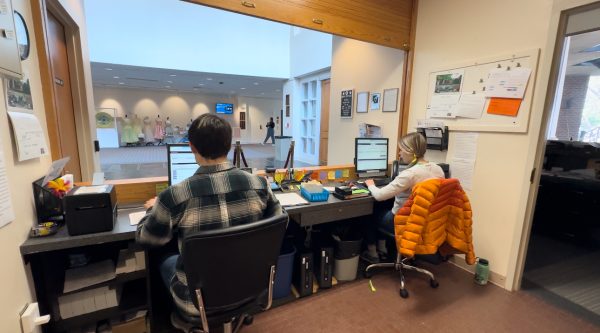Cold War prisoner shares story
Mario Röllig shared his experiences, lessons learned as a former prisoner in Cold War
March 28, 2016
Former Cold War prisoner Mario Röllig described his experiences that almost ruined his life to a Washington & Lee audience in a lecture Monday, March 21.
Röllig is currently serving as UNC Charlotte’s “Eyewitness in Residence” and is touring across the United States to share his story.
Röllig gave his account in his native tongue of German, but UNCC Language and Culture Studies Professor Anabel Aliaga-Buchenau translated the lecture into English.
Röllig was born and raised in East Berlin and described his childhood as “comfy.” He had family and friends in the West Germany and was often connected to the western world.
At a young age, Röllig’s rebellious side became evident, and his parents warned him to be careful.
“On the other side of that apartment door, I was not supposed to have an opinion,” Röllig said.
Röllig recalled being taught in kindergarten that West Germany and the United States were their mortal enemies. Instead of throwing balls around in gym class, East German kids threw fake hand grenades.
At the age of 17, Röllig came out as gay. On a vacation to Budapest, he found a boyfriend—a 43-year-old West German politician, who often visited Röllig in East Germany. The STASI, the East German police, took note and demanded Röllig to spy on his boyfriend. He refused and lost his job within three weeks.
Life in East Germany soon became miserable for Röllig. He could only find a job as a dishwasher and was under constant scrutiny. It was then that Röllig decided to escape to the West.
On June 25, 1987, Röllig flew to Budapest and hitchhiked to southern Hungary, where he planned to cross into Yugoslavia. He hid in the Hungarian countryside, waiting for the right time to run.
One night, the moment struck. Röllig began running for the border when he heard violent screaming. It was a farmer, who was acting as an extension of the STASI. Röllig tripped insight of the border, and was caught by the man.
Röllig was immediately sent to be imprisoned in Budapest. Soon after, he was then sent to Hohenschönhausen Prison in East Berlin.
Upon his arrival at the East German prison, Röllig was interrogated and tortured. The STASI had even chosen an interrogator that looked like his boyfriend.
He confessed his attempted-escape, and was told that he would serve two to eight years in Hohenschönhausen. Röllig recalls asking the agent why he was being treated so severely.
He was told that he had “betrayed his homeland, threatened world peace, and provoked a nuclear war.”
Röllig was then tortured by the STASI, and for him, there was no end in sight.
The STASI forced Röllig’s parents to sign a form admitting that they no longer had a son. Luckily, they were able to be in touch with their West German family, who hired a lawyer.
One day, while sitting in an outdoor cage, Röllig had an epiphany. He watched a blue and white Pan-Am plane fly above, and vowed to one-day fly on one himself. At that moment, he made a promise to himself, saying, “I’m not going to cry a single tear for these pigs.”
Röllig’s parents hired a lawyer who was able to convince West Germany to pay for the release of Röllig. After three months, Röllig was free.
On March 7, 1988, STASI agents put Röllig on a train to West Germany. They told him that if he were on eastern territory at midnight, they would arrest him again.
At the last stop in East Germany, at 11:30 p.m., STASI agents removed Röllig from the train. With four minutes until midnight, they put him back on.
At the stroke of midnight, Röllig crossed into West Germany.
Röllig was greeted by friends and family, and quickly started his new life in West Berlin.
He described his life as happy, until one afternoon at work, he came face to face with one of his interrogators.
“It was like looking into the eyes of the devil,” Röllig said.
The encounter caused Röllig to relive his most painful memories, and he tried to overdose on prescription painkillers. A friend found Röllig and saved his life.
While in the hospital, a psychiatrist suggested that Röllig would never fully move on until he revisited Hohenschönhausen, which had since become a museum. Ever since, Röllig has been a tour guide at the museum.
“My life’s good today,” Röllig said. “That’s my revenge.”












